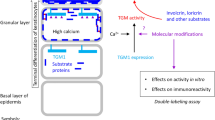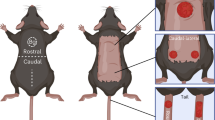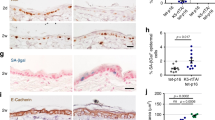Abstract
It is now widely accepted that tumour-promoting phorbol esters activate a Ca2+- and phospholipid-dependent protein kinase (protein kinase C) both in vitro and in intact cells1–3, and that the kinase represents a major cellular phorbol ester-binding protein. The phorbol esters act as analogues of diacylglycerol, a natural regulator of protein kinase C, and stabilize the membrane-association of the kinase. Although other molecular targets may exist, protein kinase C activation is probably important in mediating the diverse responses of cultured cells to phorbol esters and in promoting in vivo tumours. The enzyme comprises a family of closely related proteins4–7 and has been detected in extracts from mouse epidermal cells8–10, the likely targets for two-stage car-cinogenesis in mouse skin. In this report we show that application of a single dose of TPA (12-O-tetradecanoyl phorbol-13-acetate) to mouse skin results in a rapid and complete loss of protein kinase C activity which is maintained for 3–4 days. This is associated with a loss of immunologically detectable protein kinase C and the accumulation of a smaller protein detectable by antibodies recognizing the regulatory domain of protein kinase C.
This is a preview of subscription content, access via your institution
Access options
Subscribe to this journal
Receive 51 print issues and online access
$199.00 per year
only $3.90 per issue
Buy this article
- Purchase on Springer Link
- Instant access to full article PDF
Prices may be subject to local taxes which are calculated during checkout
Similar content being viewed by others
References
1. Nishizuka, Y. Nature 308, 693-697 (1984). 2. Nishizuka, Y. Science 233, 305-312 (1986). 3. Sekar, M. C. & Hokin, L. E. J. Membrane Biol. 89, 193-210 (1986). 4. Coussens, L. el al. Science 233, 859-866 (1986). 5. Knopf, J. et al. Cell 46, 491-502 (1986). 6. Ono, Y. et al. Science 236, 1116-1122 (1987). 7. Mousey, G. M. et al. Proc. natn. Acad. Sci. U.S.A. 84, 1065-1069 (1987). 8. Garte, S. J., Edinger, F. & Mufson, R. A. Cancer Lett. 29, 215-221 (1985). 9. Gschwendt, M. et al. Biochem. biophys. Res. Commun. 124, 63-68 (1984). 10. Kumar, R. & Holian, O. J. invest. Dermatol. 86, 316-320 (1986). 11. Parker, P. J. et al. Science 233, 853-859 (1986). 12. Stabel, S. et al. J. cell. Physiol. 130, 111-117 (1987). 13. Girard, P. R., Mazzei, G. J. & Kuo, J. F. / biol. Chem. 261, 370-375 (1986). 14. Cambier, J. C. et al. Nature 327, 629-632 (1987). 15. Murray, A. W., Fournier, A. & Hardy, S. Trends biochem. Sci. 134, 53-54 (1987). 16. Chida, K., Kato, N. & Kuroki, T. /. biol. Chem. 261, 13013-13018 (1986). 17. Tapley, P. M. & Murray, A. W. Biochem. biophys. Res. Commun. 118, 835-841 (1984). 18. Win, J. J. & Roskoski, R. Jr Analyt. Biochem. 66, 253-258 (1975). 19. Lowry, O. H., Rosenbrough, N. J., Farr, A. L. & Randall, R. J. /. biol. Chem. 193, 265-275 (1951). 20. Laemmli, U. K. Nature 227, 680-685 (1970). 21. Burnette, W. N. Analyt. Biochem. 112, 195-203 (1981). 22. Wolf, M., Cuatrecasas, P. & Sahyoun, N. J. biol. Chem. 260, 15718-15722 (1985).
Author information
Authors and Affiliations
Rights and permissions
About this article
Cite this article
Fournier, A., Murray, A. Application of phorbol ester to mouse skin causes a rapid and sustained loss of protein kinase C. Nature 330, 767–769 (1987). https://doi.org/10.1038/330767a0
Received:
Accepted:
Issue Date:
DOI: https://doi.org/10.1038/330767a0
This article is cited by
-
Tumour necrosis factor-α mediates tumour promotion via a PKCα- and AP-1-dependent pathway
Oncogene (2002)
-
Regression, proliferation and development of lip papillomas in wild white suckers,Catostomus commersoni, held in the laboratory
Environmental Biology of Fishes (1994)
-
Regulation of protein kinase C and role in cancer biology
Cancer and Metastasis Reviews (1994)
-
Further identification of protein kinase C isozymes in mouse epidermis
Journal of Cancer Research and Clinical Oncology (1993)
-
1-Dehydro-melengestrol acetate inhibitis the growth and protein kinase C activity of androgen-independent Dunning rat prostatic tumors
Cancer Chemotherapy and Pharmacology (1993)
Comments
By submitting a comment you agree to abide by our Terms and Community Guidelines. If you find something abusive or that does not comply with our terms or guidelines please flag it as inappropriate.



